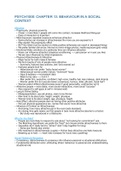Summary
Summary PSYCH1000 Chapter 13 lecture & textbook notes
- Institution
- University Of Western Ontario (UWO )
Includes integrated information from chapter 13 of the textbook as well as corresponding content from lecture. One-stop-shop for your PSYCH1000 final!
[Show more]



